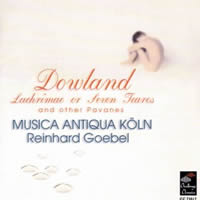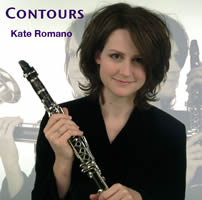Kipple 1.
|
Bart Scribner [July 2005.] Philip K. Dick’s term for encroaching junk predates the CD format by 15 years, but I got these off a street vendor in trade for some Emmy DVDs found in a dumpster dive. Close enough.
“Lachrimae or Seven Teares and other Pavanes.” By John DOWLAND, Heinrich SCHEIDEMANN, Johann SCHOP, Anthony HOLBORNE, Carlo FARINA, Samuel SCHEIDT. Musica Antiqua Köln, Reinhard Goebel (leader). Challenge Classics CC 72017 (http://www.challengerecords.com/). Distributed in the US by Allegro (http://www.allegro-music.com/). Except for curiously dull accompaniments to star singers, Goebel / MAK promises distinction. This is the most intriguing of their three programs on a small Dutch label (I guess DG Archiv doesn’t mind). Dowland’s 1604 Lachrimae is a century older than the early-Baroque figures they usually bring to life (see the editor’s salute to their Biber); the obscure names provide a look at later developments. Lachrimae failed as job application (so did the Brandenburgs) but soared in expanding Dowland’s lute world to viol quintet; a single lute summarizes or offers directions. The great pavanes’ number may relate to Lassus’ Seven Penitential Psalms (pub. 1584) or his seven-times-three Tears of St. Peter (pub. 1595). In any case, Dowland’s seven Latin titles exploit a range of weeping — old tears, old tears renewed, sighing tears, sad tears, forced tears, lover’s tears, true tears (of the spirit?). Filled with allusion, borrowing (from Dowland himself or others) and crossed or faked relations, they sound very similar when heard one after another (as here) but contain traps in different spots. Goebel concedes “Dowland was hardly thinking of the high Baroque lamento scoring such as Biber or Schmelzer would have used and which can be heard on this recording” — violins rather than viols and no lute part. Still, he respects the darker viol sonority with a layout of one violin, three violas and one cello, and by leading the violas. MAK isn’t far from its 1984 Art of Fugue (DG Archiv Masters 447293), the most credible in style of the orchestral versions. Tempos are keenly judged, lingering but never sleepy, ready to seize on twists in the flow. (The dissonances of Lachrimae Amantis have seldom rung out so strongly.) From the remaining 14 dances in Lachrimae, Goebel takes only Semper Dowland semper dolens (Ever Dowland, ever doleful). The self-portrait is the most ingenious of the lot, working a Peter Philips citation and the much-adapted In Nomine into the last section. The Image of Melancholy, by Dowland’s great friend Anthony Holborne (c. 1545-1602), is a real plus. (Its only other present listing, a quintet of recorders, wouldn’t please me.) A top lutenist and “Gentleman Usher” at Elizabeth’s court, Holborne could stand more attention. To give the strings a break, harpsichordist Christian Rieger does a Pavana Lachrimae attributed to Scheidemann, whose “sunny cheerfulness” (W.A. Grieve-Smith) would seem all wrong. His teacher Sweelinck is the obvious model — an ornamented reading of the tune, then division-like variations. Schop’s violin piece of the same title (1646) sets us on the path to Biber (he was two that year). Goebel lends it as much weight as it can bear, and stays nimble. The three pavanes from northern Germany illustrate the new, less ordered approach. Two violins carry the argument, above functional viola and continuo parts. This is a worthy adjunct to a compleat rendition of Dowland’s book. Besides being the patron saint of dystopian s.f., Philip K. Dick admired Dowland (Flow My Tears, the Policeman Said, a 1974 novel) and Stax electrostatic headphones.
“Contours.” By Franco DONATONI, William O. SMITH, Sohrab UDUMAN, Richard CAUSTON, James DILLON, Kate ROMANO, Salvatore SCIARRINO, James ERBER, Christopher FOX. Kate Romano (clarinets). Metier MSV CD92074 (http://www.metierrecords.co.uk/). Clarinetist Romano’s notes barely address the contents — six pages of chat on performer pitfalls. For a player who dislikes rules, she sports an oddly small, neat tone, at times flute-like. Anyway, nine unfamiliar works: At 16:25 Erber’s Strange Moments of Intimacy (1999-2001) is by far the longest and most notable effort. Pace and pitches are rigorous in the first half. I imagine a film with sharply cut still shots, not markedly unlike each other, creating perspective and tension. Erber employs mouthpiece sibilants of several types to clear the slate, and key clicks as punctuation. Slurs, glissandos high and low, and fragments of riffs join in; the proceedings stop without emphasis. I applaud Romano’s skill at stressing individual notes during rapid runs, and the whole is highly inventive within its chosen limits. Sciarrino’s Let Me Die Before I Wake (1982) is a trifle in his large catalog, but very effective among this athletic stuff. Static, tentative and trembling, its wiry lines often suggest a theremin. Anxiety breeds in the icy / squalling juxtapositions. An all-Sciarrino disc (Stradivarius STR 33539) might make entry easier. I love the Donatoni scores resembling musical shipwrecks, with players bobbing up and then sinking back under the surface. On the solo level, such busyness has less merit. The vaulting opening gambit in Clair (1980), repeated three more times, has me thinking Rhapsody in Blue, no doubt in error. From Romano, Dillon’s Crossing Over (1978) cuts more often than it bludgeons. (On the O/P Montaigne MO 782037, Armand Angster perhaps projected more heroism.) These avant gardens — chuttering, honking, overblowing, pitch-bending — haven’t worn well. An overdubbed Romano handles the two clarinets of Causton’s Two Pieces (1995). “Grizzly Bear Jam” is relatively flat, but “Song to End Mourning” puts the second instrument to some use. The soft, hopeful air moves from discord (one Romano stuck, the other active) to close formation and eventually to union. Contour (Sohrab Uduman, 2001) suffers most from the lack of documentation. Delays, doublings, overlaps and speed tricks turn out to be uncredited “live electronics.” The thickened sounds (harmonium, harmonica, calliope) are fun, but I can’t locate much purpose. Likewise Fox’s Generic Composition #7, “for a keyed wind instrument” (1999-2001). Apparently Romano realizes it from a series of fluid elements (each playing should be different). The edgy vibrato (a frequent effect on the disc), crescendos and murmurings are probably hers. Romano’s Pied Piper (2000) is appealing as an index to what she presumably enjoys doing — snapping from low and slow to high and fast, fluttering passagework, exiting a speedy turn on an upward glissando. She ends on a sudden echo (backing away from the mic?). Variants (William O. Smith, 1963) sits dangerously near those compilations of “mood music” for one’s home movies. Six tracks (0:31 to 1:17) scarcely deviate from their titles. Equipment
No wall outlets, so battery operation is a must. The discontinued units date from 1994. Grado’s current gear (RA-1 amp, RS-1 phones) may improve on these — or not, given the prices the older models still fetch. The ringer is Doede Douma’s kit DAC. Mine was built by a gifted engineer / guitarist in 2003 (thanks, Wim); no preassembled ones exist. The kit can be had for 115 euros, but we spent three times that going high ticket in all areas, cosmetics included. (When I run out of batteries, I still have to look at it.) A ladder of eight paralleled TDA1543 chips is the engine. Reportedly it slays some kilobuck processors, but I’ve no view on that; it speaks truthfully. Of course, if someone has a Stax DAC-Talent BD to unload….
C Farina, C Fox, Causton, Dillon, Donatoni, Dowland, Erber, Holborne, Romano, Scheidmann, Scheidt, Schop, Sciarrino, Uduman, WO Smith
[More Bart Scribner, Kipple]
[More
C Farina, C Fox, Causton, Dillon, Donatoni, Dowland, Erber, Holborne, Romano, Scheidmann, Scheidt, Schop, Sciarrino, Uduman, WO Smith]
[Previous Article:
Mostly Symphonies]
[Next Article:
Luigi Dallapiccola: For Orchestra]
|

